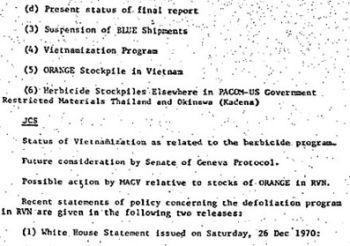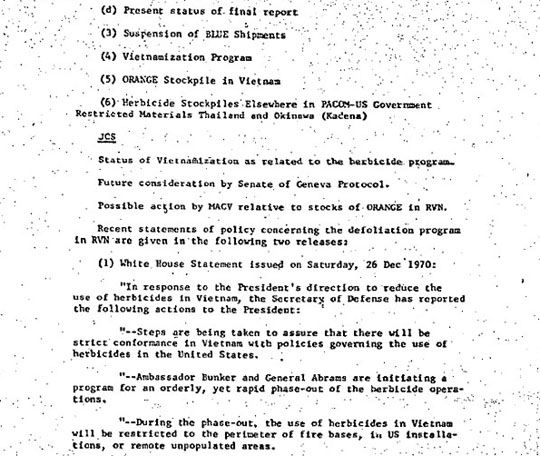
Publisher:
Bonnie King
CONTACT:
Newsroom@Salem-news.com
Advertising:
Adsales@Salem-news.com

~Truth~
~Justice~
~Peace~
TJP
Jan-11-2013 18:46

 TweetFollow @OregonNews
TweetFollow @OregonNews
Kadena Kept Agent Orange: '71 Army Paper
Jon Mitchell Special to Salem-News.comThe U.S. government already admits that it stored military herbicides in Thailand during the Vietnam War but it denies their presence in Okinawa.
 Paper trail: Part of a 1971 document recently released by the Pentagon has a single sentence saying the U.S. military stored toxic herbicides, including Agent Orange, in Okinawa during the Vietnam War. COURTESY OF STEVE HOUSE |
(WASHINGTON DC Japan Times) - A single sentence buried among 7,000 pages of documents recently released by the Pentagon might well be the needle in the haystack that conclusively proves the U.S. military stored toxic herbicides, including Agent Orange, in Okinawa during the Vietnam War.
American veterans have long claimed that large volumes of these chemicals were present on Okinawa Island and hundreds of them are suffering serious illnesses they believe were triggered by their exposure. But the U.S. government has repeatedly denied the allegations by insisting it has no records related to the issue.
The latest discovery in a 1971 report titled "Historical, logistical, political and technical aspects of the herbicide/defoliant program" indicates the Pentagon's denials might not have been entirely correct.
The document, produced in September 1971 by U.S. Army Fort Detrick, Maryland, the center for the Pentagon's biochemical weapons research, summarized the military's usage of these chemicals during the Vietnam War and among the locations cited is a reference to "Herbicide stockpiles elsewhere in PACOM-U.S. (Pacific Command) government restricted materials Thailand and Okinawa (Kadena)."
The U.S. government already admits that it stored military herbicides in Thailand during the Vietnam War but it denies their presence in Okinawa. At the time, Kadena Air Base (near the city of Okinawa) served as the Pentagon's key supply hub through which weapons and ammunition were flown to the conflict in Southeast Asia.
The Fort Detrick report was among a cache of U.S. Army documents declassified last October under the Freedom of Information Act at the request of Steve House, one of the veterans at the center of the 2011 investigation into the burial of Agent Orange in South Korea.
House discovered the reference to Kadena along with Michelle Gatz, a Minnesota-based veterans services officer who has been researching herbicide usage in Okinawa.
"While I am sure the U.S. government will try to discredit the report, it will help to prove veterans' claims that they were exposed to herbicides on Okinawa,"Gatz told The Japan Times. "It might even be enough proof for them to receive government benefits for the health problems they're suffering."
Fort Detrick drew up the report in response to a 1970 Washington ban on the military's use of Agent Orange due to evidence that the defoliants the air force had been spraying in Vietnam for almost a decade caused birth defects. The report chronicles the military's confusion as to how best to dispose of its surplus stocks of millions of liters of herbicides following their prohibition.
Some of the proposals floated in the report include using the toxic defoliants in "undeveloped nations" under the auspices of U.S. aid programs or "burial in soil pits or settling ponds."
The latter suggestion will be of particular concern to Okinawa residents since U.S. veterans stationed in the prefecture have claimed such burials of unwanted herbicides took place on the premises of U.S. Marine Corps Air Station Futenma and on former military land in the town of Chatan, northeast of Naha, Okinawa's capital.
According to experts, the dioxin contained in the herbicide can contaminate the ground for decades and cause serious harm to people living nearby. In Vietnam, land where the U.S. military stored Agent Orange during the war remains dangerously polluted and the Vietnamese Red Cross estimates that approximately 3 million people are suffering from the effects of exposure to these chemicals.

The discovery of the Fort Detrick document comes soon after the release of another U.S. military report implicating the air force in the storage of Agent Orange in Okinawa.
"An Ecological Assessment of Johnston Atoll," revealed in a story in The Japan Times last August, stated the U.S. Air Force transported 25,000 barrels of Agent Orange from Okinawa to Johnston Island, west of Hawaii, for disposal in 1972.
When confronted with the Johnston Island report last September, Washington was quick to distance itself from the contents. It told the Foreign Ministry in Tokyo that it had reinvestigated its own records and had come to the conclusion that "the description that '(Herbicide Orange) was stored in Okinawa' is inaccurate and contradicts with the facts that the U.S. government acknowledges."
In reply, Japan stated it believed the U.S. explanation and it has been reluctant to pursue the matter further.
Masami Kawamura, environmental justice director of Citizens' Network for Biodiversity in Okinawa, the NGO calling for a full investigation into Agent Orange usage in the prefecture, is not convinced by Washington's reply to Tokyo.
"For many years, the U.S. government had been saying there were no documents related to herbicides on Okinawa. But in August the Johnston Island ecological assessment turned up and their reaction was to call it inaccurate. Now this new report has been uncovered. Will they try to say it is inaccurate, too?" Kawamura asked.
When asked for comment for this article, Lt. Col. David Honchul, director of public affairs at U.S. Forces Japan, reiterated the Pentagon's commitment to investigate allegations of Agent Orange in Okinawa.
As to the latest Kadena allegations, he declined comment in detail about the Fort Detrick report, but concluded, "It doesn't change our position that there is no documentary evidence that Agent Orange or similar herbicides were ever used in, stored on, or shipped through Okinawa."
Kadena Air Base remains the largest U.S. Air Force installation in the Pacific, and is home to approximately 22,000 service members, their families and civilian contractors. Some 180,000 people live in the adjoining municipalities of Chatan, Kadena and the city of Okinawa.
Special thanks to Chuck Palazzo and Agent Orange Action Group
Articles for January 10, 2013 | Articles for January 11, 2013 | Articles for January 12, 2013

Quick Links
DINING
Willamette UniversityGoudy Commons Cafe
Dine on the Queen
Willamette Queen Sternwheeler
MUST SEE SALEM
Oregon Capitol ToursCapitol History Gateway
Willamette River Ride
Willamette Queen Sternwheeler
Historic Home Tours:
Deepwood Museum
The Bush House
Gaiety Hollow Garden
AUCTIONS - APPRAISALS
Auction Masters & AppraisalsCONSTRUCTION SERVICES
Roofing and ContractingSheridan, Ore.
ONLINE SHOPPING
Special Occasion DressesAdvertise with Salem-News
Contact:AdSales@Salem-News.com

Salem-News.com:
googlec507860f6901db00.html

Terms of Service | Privacy Policy
All comments and messages are approved by people and self promotional links or unacceptable comments are denied.
minness justice September 4, 2013 5:31 am (Pacific time)
I was at Kadena Air Base from 1971-1772. I saw Japanese workers spraying agent orange. I was told by my supervisors to stay away from that stuff, because it was the same thing the U.S. Army was using to kill trees and People in Vietnam.
[Return to Top]©2025 Salem-News.com. All opinions expressed in this article are those of the author and do not necessarily reflect those of Salem-News.com.